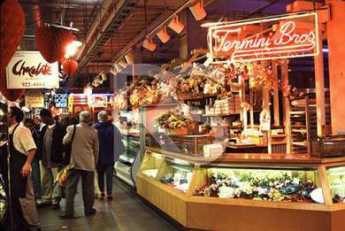Related Topics
Particular Sights to See:Center City
Taxi drivers tell tourists that Center City is a "shining city on a hill". During the Industrial Era, the city almost urbanized out to the county line, and then retreated. Right now, the urban center is surrounded by a semi-deserted ring of former factories.
Market Street, East (2)

|
| The Reading Terminal Market |
We are about to look at a remarkable a fourteen-block stretch of street, with several unifying historical themes, but there is one notable feature which stands by itself. The PSFS building is now the site of a luxury hotel, but it once housed the Philadelphia Savings Fund Society, the oldest savings bank in the country, having been founded in 1816. Setting aside the place of this the institution in American finance, and passing quickly by the deplorable end of it with swashbuckling corsairs in three-piece suits, 1929 the building itself remains so remarkable that the hotel still displays the PSFS sign on its top. The imagination of the architects was so advanced that a building constructed seventy-five years ago looks as though it might have been completed yesterday. The Smithsonian Institution conducts annual five-day tours of Chicago to look at a skyscraper architecture, but hardly anything on that tour compares with the PSFS building. From time to time, someone digs up old newspaper clippings from the 1930s to show how the PSFS was ridiculed for its odd-looking the building, but anyhow this is certainly one example of how the Avante the guard got it right.
At the far Eastern end of Market Street, right in the middle of the street once stood a head house, which in this case was called the market terminal building
. In those days, street markets were mostly a line of sheds and carts down the middle of a wide street, but usually there was a substantial masonry building at the head of the market, where money was counted and more easily guarded. An example of a restored ahead house can today be found at Second and Pine, although that market ("Newmarket") was less for groceries than for upscale shops. The market on Market Street started at the river and worked West with the advancing city limits, making it understandable that buildings which lined that broad avenue gradually converted to shops, and then stores. The grandest of the department stores on Market Street was, of course, John Wanamaker's, all the way to City Hall, built on the site of Pennsylvania Railroad's freight terminal (the passenger terminal was on the West side of City Hall). In the late Nineteenth Century, the Pennsylvania Railroad and the Reading Railroads terminated at this point, so rail traffic flowing east merged with ocean and river traffic flowing west. Well into the Twentieth Century, a dozen major department stores and hundreds of specialty stores lined the street, with trolley cars, buses, and subway traffic taking over for horse-drawn drainage. The the pinnacle of this process was the corner of Eighth and Market, where four department stores stood, one on each corner, and underneath them three subway systems intersected. The Reading terminal market is Philadelphia's last remnant of this almost medieval shopping concept, although the Italian street markets of South Philadelphia display a more authentic chaos. Street markets, followed by shops, overwhelmed by department stores showed a regular succession up Market Street, and when commerce disappeared, it all turned into a wide avenue from City Hall to River, leaving few colonial traces.
The history of Market Street is the history of the Reading Terminal Market. Farmers and local artisans thronged to sell their wares in sheds put up in the middle of the wide street, traditionally called "shambles" after the similar areas in York, England. Gradually, elegant stores were built on the street, and upscale competitors began to be uncomfortable with the mess and disorder of the shambles down the center of the street. By 1859 the power structure had changed, and the upscale merchants on the sidewalks got a law passed, forbidding shambles. After the expected uproar, the farmers and other shambles merchants got organized, and built a Farmers Market on the North side of 12th and Market Relative peace and commercial tranquility then prevailed until the Reading Railroad employed power politics and the right of eminent domain to displace the Farmer's Marketplace with a downtown railroad terminal that was an architectural marvel for its time, with the farmers displaced to the rear in the Reading Terminal Market, opening in 1893. Bassett's, the ice cream maker, is the only merchant continuously in business there since it opened, but several other vendors are nearly as old. The farmers market persisted in that form for a century until the City built a convention center next door. As a result, the quaint old farmers market became a tourist attraction, with over 90,000 visitors a week. That's fine if you are selling sandwiches and souvenirs, but it crowds out meat and produces and thereby creates a problem. If the tourist attraction gets too popular, it drives out everything which made it a tourist attraction; so rules had to be made and enforced, limiting the number of restaurants, but encouraging Pennsylvania Dutch farmers. Competition and innovation are the lifeblood of commercial real estate, but they are always noisy processes. The history of the street is the history of clamor and jostling, eventually dying out to the point where everyone is regretful and nostalgic for a revival of clamor.
Originally published: Friday, June 23, 2006; most-recently modified: Thursday, May 23, 2019